Kaiyu Li
Annotation-Free Open-Vocabulary Segmentation for Remote-Sensing Images
Aug 25, 2025Abstract:Semantic segmentation of remote sensing (RS) images is pivotal for comprehensive Earth observation, but the demand for interpreting new object categories, coupled with the high expense of manual annotation, poses significant challenges. Although open-vocabulary semantic segmentation (OVSS) offers a promising solution, existing frameworks designed for natural images are insufficient for the unique complexities of RS data. They struggle with vast scale variations and fine-grained details, and their adaptation often relies on extensive, costly annotations. To address this critical gap, this paper introduces SegEarth-OV, the first framework for annotation-free open-vocabulary segmentation of RS images. Specifically, we propose SimFeatUp, a universal upsampler that robustly restores high-resolution spatial details from coarse features, correcting distorted target shapes without any task-specific post-training. We also present a simple yet effective Global Bias Alleviation operation to subtract the inherent global context from patch features, significantly enhancing local semantic fidelity. These components empower SegEarth-OV to effectively harness the rich semantics of pre-trained VLMs, making OVSS possible in optical RS contexts. Furthermore, to extend the framework's universality to other challenging RS modalities like SAR images, where large-scale VLMs are unavailable and expensive to create, we introduce AlignEarth, which is a distillation-based strategy and can efficiently transfer semantic knowledge from an optical VLM encoder to an SAR encoder, bypassing the need to build SAR foundation models from scratch and enabling universal OVSS across diverse sensor types. Extensive experiments on both optical and SAR datasets validate that SegEarth-OV can achieve dramatic improvements over the SOTA methods, establishing a robust foundation for annotation-free and open-world Earth observation.
RS-MTDF: Multi-Teacher Distillation and Fusion for Remote Sensing Semi-Supervised Semantic Segmentation
Jun 11, 2025Abstract:Semantic segmentation in remote sensing images is crucial for various applications, yet its performance is heavily reliant on large-scale, high-quality pixel-wise annotations, which are notoriously expensive and time-consuming to acquire. Semi-supervised semantic segmentation (SSS) offers a promising alternative to mitigate this data dependency. However, existing SSS methods often struggle with the inherent distribution mismatch between limited labeled data and abundant unlabeled data, leading to suboptimal generalization. To alleviate this issue, we attempt to introduce the Vision Foundation Models (VFMs) pre-trained on vast and diverse datasets into the SSS task since VFMs possess robust generalization capabilities that can effectively bridge this distribution gap and provide strong semantic priors for SSS. Inspired by this, we introduce RS-MTDF (Multi-Teacher Distillation and Fusion), a novel framework that leverages the powerful semantic knowledge embedded in VFMs to guide semi-supervised learning in remote sensing. Specifically, RS-MTDF employs multiple frozen VFMs (e.g., DINOv2 and CLIP) as expert teachers, utilizing feature-level distillation to align student features with their robust representations. To further enhance discriminative power, the distilled knowledge is seamlessly fused into the student decoder. Extensive experiments on three challenging remote sensing datasets demonstrate that RS-MTDF consistently achieves state-of-the-art performance. Notably, our method outperforms existing approaches across various label ratios on LoveDA and secures the highest IoU in the majority of semantic categories. These results underscore the efficacy of multi-teacher VFM guidance in significantly enhancing both generalization and semantic understanding for remote sensing segmentation. Ablation studies further validate the contribution of each proposed module.
SegEarth-R1: Geospatial Pixel Reasoning via Large Language Model
Apr 13, 2025Abstract:Remote sensing has become critical for understanding environmental dynamics, urban planning, and disaster management. However, traditional remote sensing workflows often rely on explicit segmentation or detection methods, which struggle to handle complex, implicit queries that require reasoning over spatial context, domain knowledge, and implicit user intent. Motivated by this, we introduce a new task, \ie, geospatial pixel reasoning, which allows implicit querying and reasoning and generates the mask of the target region. To advance this task, we construct and release the first large-scale benchmark dataset called EarthReason, which comprises 5,434 manually annotated image masks with over 30,000 implicit question-answer pairs. Moreover, we propose SegEarth-R1, a simple yet effective language-guided segmentation baseline that integrates a hierarchical visual encoder, a large language model (LLM) for instruction parsing, and a tailored mask generator for spatial correlation. The design of SegEarth-R1 incorporates domain-specific adaptations, including aggressive visual token compression to handle ultra-high-resolution remote sensing images, a description projection module to fuse language and multi-scale features, and a streamlined mask prediction pipeline that directly queries description embeddings. Extensive experiments demonstrate that SegEarth-R1 achieves state-of-the-art performance on both reasoning and referring segmentation tasks, significantly outperforming traditional and LLM-based segmentation methods. Our data and code will be released at https://github.com/earth-insights/SegEarth-R1.
Semantically Robust Unsupervised Image Translation for Paired Remote Sensing Images
Feb 17, 2025Abstract:Image translation for change detection or classification in bi-temporal remote sensing images is unique. Although it can acquire paired images, it is still unsupervised. Moreover, strict semantic preservation in translation is always needed instead of multimodal outputs. In response to these problems, this paper proposes a new method, SRUIT (Semantically Robust Unsupervised Image-to-image Translation), which ensures semantically robust translation and produces deterministic output. Inspired by previous works, the method explores the underlying characteristics of bi-temporal Remote Sensing images and designs the corresponding networks. Firstly, we assume that bi-temporal Remote Sensing images share the same latent space, for they are always acquired from the same land location. So SRUIT makes the generators share their high-level layers, and this constraint will compel two domain mapping to fall into the same latent space. Secondly, considering land covers of bi-temporal images could evolve into each other, SRUIT exploits the cross-cycle-consistent adversarial networks to translate from one to the other and recover them. Experimental results show that constraints of sharing weights and cross-cycle consistency enable translated images with both good perceptual image quality and semantic preservation for significant differences.
SPECIAL: Zero-shot Hyperspectral Image Classification With CLIP
Jan 27, 2025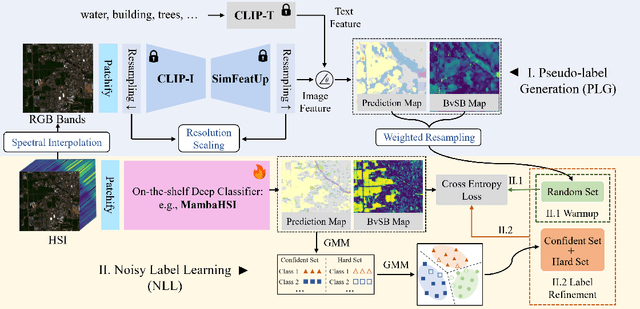

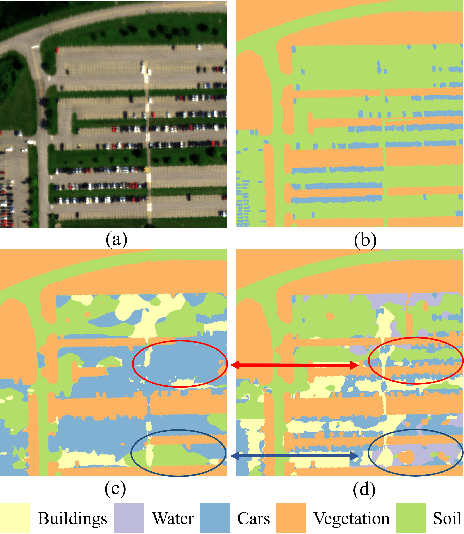

Abstract:Hyperspectral image (HSI) classification aims at categorizing each pixel in an HSI into a specific land cover class, which is crucial for applications like remote sensing, environmental monitoring, and agriculture. Although deep learning-based HSI classification methods have achieved significant advancements, existing methods still rely on manually labeled data for training, which is both time-consuming and labor-intensive.To address this limitation, we introduce a novel zero-shot hyperspectral image classification framework based on CLIP (SPECIAL), aiming to eliminate the need for manual annotations. The SPECIAL framework consists of two main stages: (1) CLIP-based pseudo-label generation, and (2) noisy label learning. In the first stage, HSI is spectrally interpolated to produce RGB bands. These bands are subsequently classified using CLIP, resulting in noisy pseudo-labels that are accompanied by confidence scores.To improve the quality of these labels, we propose a scaling strategy that fuses predictions from multiple spatial scales. In the second stage, spectral information and a label refinement technique are incorporated to mitigate label noise and further enhance classification accuracy. Experimental results on three benchmark datasets demonstrate that our SPECIAL outperforms existing methods in zero-shot HSI classification, showing its potential for more practical applications. The code is available at https://github.com/LiPang/SPECIAL.
Towards Satellite Image Road Graph Extraction: A Global-Scale Dataset and A Novel Method
Nov 23, 2024Abstract:Recently, road graph extraction has garnered increasing attention due to its crucial role in autonomous driving, navigation, etc. However, accurately and efficiently extracting road graphs remains a persistent challenge, primarily due to the severe scarcity of labeled data. To address this limitation, we collect a global-scale satellite road graph extraction dataset, i.e. Global-Scale dataset. Specifically, the Global-Scale dataset is $\sim20 \times$ larger than the largest existing public road extraction dataset and spans over 13,800 $km^2$ globally. Additionally, we develop a novel road graph extraction model, i.e. SAM-Road++, which adopts a node-guided resampling method to alleviate the mismatch issue between training and inference in SAM-Road, a pioneering state-of-the-art road graph extraction model. Furthermore, we propose a simple yet effective ``extended-line'' strategy in SAM-Road++ to mitigate the occlusion issue on the road. Extensive experiments demonstrate the validity of the collected Global-Scale dataset and the proposed SAM-Road++ method, particularly highlighting its superior predictive power in unseen regions. The dataset and code are available at \url{https://github.com/earth-insights/samroadplus}.
MV-CC: Mask Enhanced Video Model for Remote Sensing Change Caption
Oct 31, 2024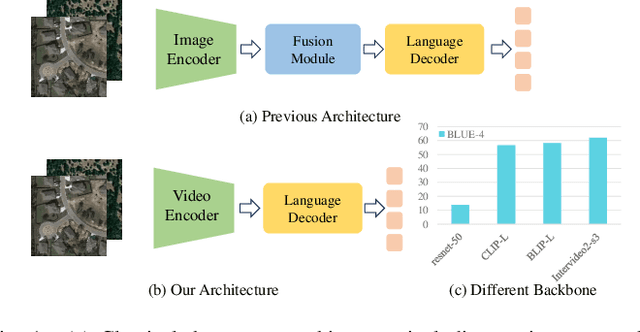
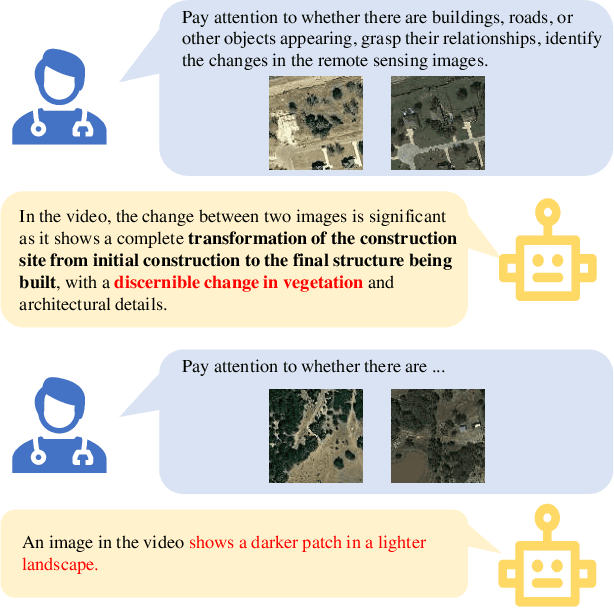
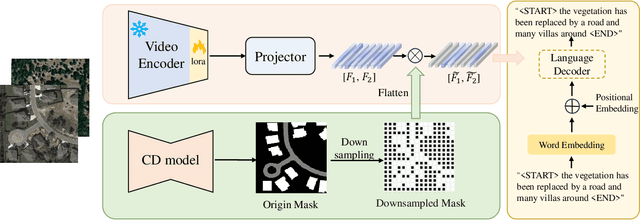

Abstract:Remote sensing image change caption (RSICC) aims to provide natural language descriptions for bi-temporal remote sensing images. Since Change Caption (CC) task requires both spatial and temporal features, previous works follow an encoder-fusion-decoder architecture. They use an image encoder to extract spatial features and the fusion module to integrate spatial features and extract temporal features, which leads to increasingly complex manual design of the fusion module. In this paper, we introduce a novel video model-based paradigm without design of the fusion module and propose a Mask-enhanced Video model for Change Caption (MV-CC). Specifically, we use the off-the-shelf video encoder to simultaneously extract the temporal and spatial features of bi-temporal images. Furthermore, the types of changes in the CC are set based on specific task requirements, and to enable the model to better focus on the regions of interest, we employ masks obtained from the Change Detection (CD) method to explicitly guide the CC model. Experimental results demonstrate that our proposed method can obtain better performance compared with other state-of-the-art RSICC methods. The code is available at https://github.com/liuruixun/MV-CC.
SegEarth-OV: Towards Traning-Free Open-Vocabulary Segmentation for Remote Sensing Images
Oct 02, 2024Abstract:Remote sensing image plays an irreplaceable role in fields such as agriculture, water resources, military, and disaster relief. Pixel-level interpretation is a critical aspect of remote sensing image applications; however, a prevalent limitation remains the need for extensive manual annotation. For this, we try to introduce open-vocabulary semantic segmentation (OVSS) into the remote sensing context. However, due to the sensitivity of remote sensing images to low-resolution features, distorted target shapes and ill-fitting boundaries are exhibited in the prediction mask. To tackle this issue, we propose a simple and general upsampler, SimFeatUp, to restore lost spatial information in deep features in a training-free style. Further, based on the observation of the abnormal response of local patch tokens to [CLS] token in CLIP, we propose to execute a straightforward subtraction operation to alleviate the global bias in patch tokens. Extensive experiments are conducted on 17 remote sensing datasets spanning semantic segmentation, building extraction, road detection, and flood detection tasks. Our method achieves an average of 5.8%, 8.2%, 4%, and 15.3% improvement over state-of-the-art methods on 4 tasks. All codes are released. \url{https://earth-insights.github.io/SegEarth-OV}
Open-CD: A Comprehensive Toolbox for Change Detection
Jul 22, 2024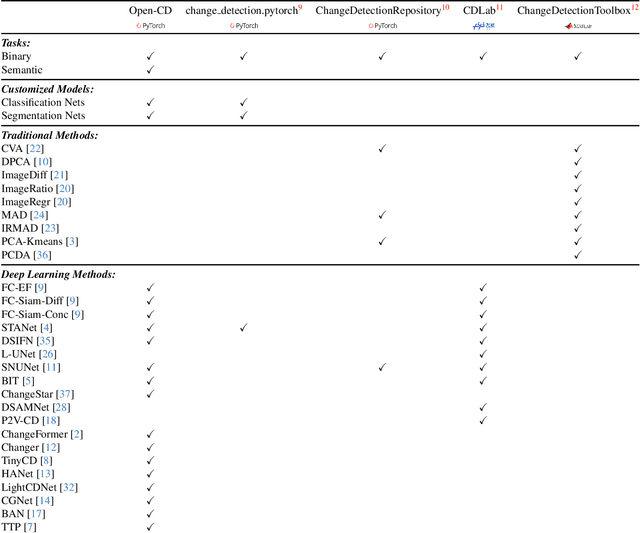
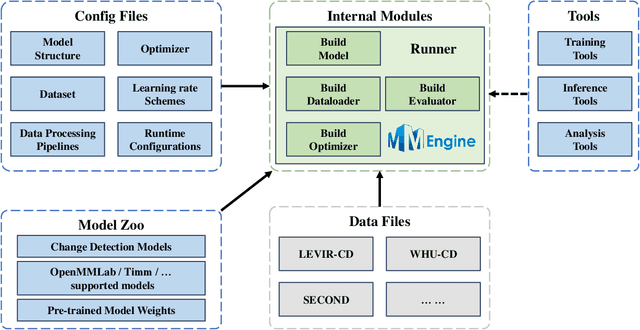

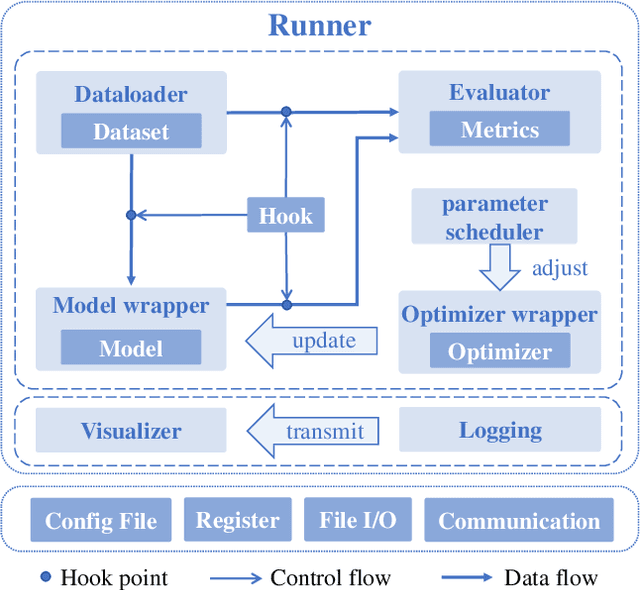
Abstract:We present Open-CD, a change detection toolbox that contains a rich set of change detection methods as well as related components and modules. The toolbox started from a series of open source general vision task tools, including OpenMMLab Toolkits, PyTorch Image Models, etc. It gradually evolves into a unified platform that covers many popular change detection methods and contemporary modules. It not only includes training and inference codes, but also provides some useful scripts for data analysis. We believe this toolbox is by far the most complete change detection toolbox. In this report, we introduce the various features, supported methods and applications of Open-CD. In addition, we also conduct a benchmarking study on different methods and components. We wish that the toolbox and benchmark could serve the growing research community by providing a flexible toolkit to reimplement existing methods and develop their own new change detectors. Code and models are available at \url{https://github.com/likyoo/open-cd}. Pioneeringly, this report also includes brief descriptions of the algorithms supported in Open-CD, mainly contributed by their authors. We sincerely encourage researchers in this field to participate in this project and work together to create a more open community. This toolkit and report will be kept updated.
DiffMatch: Visual-Language Guidance Makes Better Semi-supervised Change Detector
May 08, 2024Abstract:Change Detection (CD) aims to identify pixels with semantic changes between images. However, annotating massive numbers of pixel-level images is labor-intensive and costly, especially for multi-temporal images, which require pixel-wise comparisons by human experts. Considering the excellent performance of visual language models (VLMs) for zero-shot, open-vocabulary, etc. with prompt-based reasoning, it is promising to utilize VLMs to make better CD under limited labeled data. In this paper, we propose a VLM guidance-based semi-supervised CD method, namely DiffMatch. The insight of DiffMatch is to synthesize free change labels using VLMs to provide additional supervision signals for unlabeled data. However, almost all current VLMs are designed for single-temporal images and cannot be directly applied to bi- or multi-temporal images. Motivated by this, we first propose a VLM-based mixed change event generation (CEG) strategy to yield pseudo labels for unlabeled CD data. Since the additional supervised signals provided by these VLM-driven pseudo labels may conflict with the pseudo labels from the consistency regularization paradigm (e.g. FixMatch), we propose the dual projection head for de-entangling different signal sources. Further, we explicitly decouple the bi-temporal images semantic representation through two auxiliary segmentation decoders, which are also guided by VLM. Finally, to make the model more adequately capture change representations, we introduce metric-aware supervision by feature-level contrastive loss in auxiliary branches. Extensive experiments show the advantage of DiffMatch. For instance, DiffMatch improves the FixMatch baseline by +5.3 IoU on WHU-CD and by +2.4 IoU on LEVIR-CD with 5% labels. In addition, our CEG strategy, in an un-supervised manner, can achieve performance far superior to state-of-the-art un-supervised CD methods.
 Add to Chrome
Add to Chrome Add to Firefox
Add to Firefox Add to Edge
Add to Edge